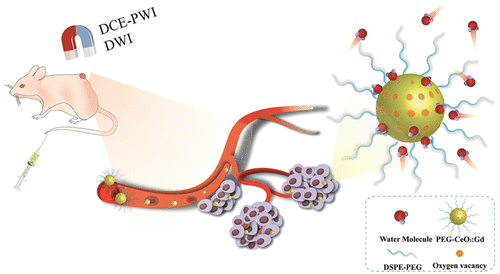Our official English website, www.x-mol.net, welcomes your
feedback! (Note: you will need to create a separate account there.)
Oxygen Vacancies Enhanced CeO2:Gd Nanoparticles for Sensing a Tumor Vascular Microenvironment by Magnetic Resonance Imaging
ACS Nano ( IF 15.8 ) Pub Date : 2018-11-29 00:00:00 , DOI: 10.1021/acsnano.8b07387 Chulun Shao 1, 2 , Aijun Shen 3 , Meng Zhang 1, 2 , Xianfu Meng 4 , Chaolin Song 4 , Yanyan Liu 4 , Xiaolong Gao 3 , Peijun Wang 3 , Wenbo Bu 1, 4
ACS Nano ( IF 15.8 ) Pub Date : 2018-11-29 00:00:00 , DOI: 10.1021/acsnano.8b07387 Chulun Shao 1, 2 , Aijun Shen 3 , Meng Zhang 1, 2 , Xianfu Meng 4 , Chaolin Song 4 , Yanyan Liu 4 , Xiaolong Gao 3 , Peijun Wang 3 , Wenbo Bu 1, 4
Affiliation

|
The specific characteristics of the tumor vascular microenvironment such as microvascular permeability and water diffusion have been demonstrated to play essential roles in the evaluation of infiltration of tumors. However, at present, there are few contrast agents (CAs) for magnetic resonance imaging to enhance the sensitivity for acquiring this vital information. Herein, we develop Gd-doped (CeO2:Gd) nanoparticles as CAs to detect the tumor vascular microenvironment with high sensitivity. The lattice oxygen vacancies on the surface of CeO2:Gd nanoparticles could bind considerable water molecules to improve the r1 value, achieving an excellent dynamic contrast-enhanced perfusion weighted imaging performance for the measurement of microvascular permeability. Diffusion limiting of water molecules by oxygen vacancies of CeO2:Gd nanoparticles further enhances the diffusion-weighted magnetic resonance imaging signal in vitro and in vivo. Excitingly, the strategy is not only essential for obtaining tumor vascular microenvironment information but also offers a way for further research in the design of magnetic resonance CAs.
中文翻译:

氧空位增强的CeO 2:Gd纳米粒子,通过磁共振成像感测肿瘤血管微环境
已经证明,肿瘤血管微环境的特定特征,例如微血管渗透性和水扩散,在评估肿瘤的浸润性方面起着至关重要的作用。但是,目前,用于磁共振成像以增强获取该重要信息的灵敏度的造影剂(CA)很少。本文中,我们开发了掺有CdO(CeO 2:Gd)的纳米粒子作为CA,以高灵敏度检测肿瘤血管微环境。CeO 2:Gd纳米颗粒表面的晶格氧空位可以结合大量水分子以改善r 1在微血管通透性的测量中,获得了出色的动态对比度增强灌注加权成像性能。扩散通过的CeO氧空位限制水分子的2:纳米颗粒的Gd进一步增强了扩散加权磁共振成像信号在体外和体内。令人兴奋的是,该策略不仅对于获得肿瘤血管微环境信息至关重要,而且为磁共振CA设计中的进一步研究提供了一种方法。
更新日期:2018-11-29
中文翻译:

氧空位增强的CeO 2:Gd纳米粒子,通过磁共振成像感测肿瘤血管微环境
已经证明,肿瘤血管微环境的特定特征,例如微血管渗透性和水扩散,在评估肿瘤的浸润性方面起着至关重要的作用。但是,目前,用于磁共振成像以增强获取该重要信息的灵敏度的造影剂(CA)很少。本文中,我们开发了掺有CdO(CeO 2:Gd)的纳米粒子作为CA,以高灵敏度检测肿瘤血管微环境。CeO 2:Gd纳米颗粒表面的晶格氧空位可以结合大量水分子以改善r 1在微血管通透性的测量中,获得了出色的动态对比度增强灌注加权成像性能。扩散通过的CeO氧空位限制水分子的2:纳米颗粒的Gd进一步增强了扩散加权磁共振成像信号在体外和体内。令人兴奋的是,该策略不仅对于获得肿瘤血管微环境信息至关重要,而且为磁共振CA设计中的进一步研究提供了一种方法。











































 京公网安备 11010802027423号
京公网安备 11010802027423号